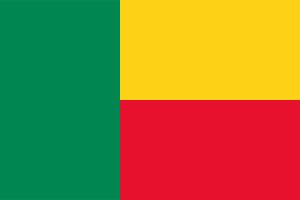
| Colors | HEX Code | RGB | CMYK |
|---|---|---|---|
| Green | #018550 | 1, 133, 80 | 99, 0, 40, 48 |
| Yellow | #FCD116 | 252, 209, 22 | 0, 17, 91, 1 |
| Red | #E8112D | 232, 17, 45 | 0, 93, 81, 9 |
The Benin flag is made of one vertical green stripe to the left, and two horizontal stripes to the right, colored yellow on the upper part and red on the lower part.
Meaning of the Benin flag
The flag of Benin is inspired by pan-African colors. The yellow represents the savannas of the northern part of the country, while the green stands for the palm groves of the south. The red refers to the blood of ancestors who protected the country and linked it together.
History of the Benin flag
Benin was a French colony. It wasn’t allowed to have a flag of its own. The country started to seek independence in the middle of the 20th century. and in the year 1959, an autonomous republic started to emerge. The flag was officially adopted on November 16, 1959. When the country gained independence in 1960, the flag remained the same and did not change. The colors were inspired by the pan-African colors. Countries like Ghana, Ethiopia, and Cameron had a profound effect on the choice of the colors of the Benin flag. Then, the country was under Marxist rule in 1972, and the flag was changed. The communist authorities adopted a green flag with a red star on the upper hoist. The flag represented the revolution and the green nature of Benin. The communist rule witnessed social and political failure until it failed and collapsed. The communist government left power in 1990, and the original flag was used again.